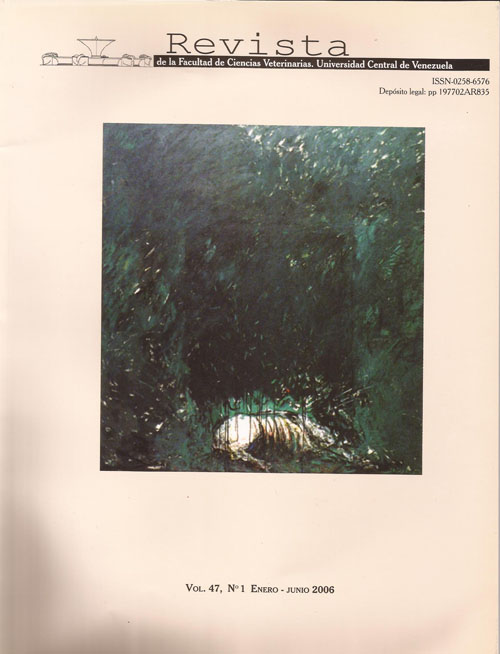EFICACIA DE LA INMUNOFLUORESCENCIA INDIRECTA PARA LA DETECCIÓN TEMPRANA DEL VIRUS DE ENCEFALITIS EQUINA VENEZOLANA EN CEREBRO DE RATONES LACTANTES
Contenido principal del artículo
Resumen
El objeto del trabajo fue estandarizar y evaluar la eficacia de la prueba de inmunofluorescencia indirecta (IFI) para detectar en forma temprana, antígeno del Virus de Encefalitis Equina Venezolana (VEEV) en cerebro de ratón lactante, utilizando la Fijación de Complemento (FC) como prueba de comparación. En principio, por IFI se detectó antígeno viral a las 10, 12 y 26 horas post inoculación (hpi) para las cepas P676, Lara 95 y TC-83, respectivamente. La sensibilidad de esta prueba para la cepa Lara-95, fue de 89% a las 24 hpi (período asintomático), en comparación con 32% para FC, indicando que la escasa cantidad de antígeno viral en las fases iniciales de la enfermedad se evidencia por la primera técnica. Además, la sensibilidad de ambas técnicas, en comparación con la prueba biológica, fue de 86% y 29% respectivamente. A las 36 horas post inoculación, en ratones con síntomas nerviosos evidentes, la sensibilidad y especificidad de ambas pruebas fue de 100%. Estos resultados indican que la inmunofluorescencia indirecta es una alternativa válida y eficiente para la evaluación de focos de Encefalitis Equina Venezolana, contribuyendo de esta manera con la vigilancia epidemiológica de la enfermedad.
Efficacy of the Indirect Immunofluorescent Test for Early Detection of Venezuelan Equine Encephalitis Virus in Suckling Mice Brain Tissue
ABSTRACT
The aim of this study was to standardize and evaluate the efficacy of the indirect immunofluorescent technique (IIFT) for early detection of Venezuelan Equine Encephalitis Virus (VEEV) antigen in the brain of suckling mice, using the Complement Fixation Test (CFT) as a comparison. Viral antigen TC-83 was detected at 10, 12 and 26 hours post-inoculation (hpi), for P-676, Lara-95 and TC-83 strains, respectively. The sensitivity of IIFT for Lara-95 strain, was 89% at 24 hpi (non symptomatic period), when compared to 32% for CFT, indicating that the low concentration of viral antigen during the early phases of the disease, can be detected with IIFT. The sensitivity of both techniques compared to the biological assay was 86% and 29% for IIFT and CFT, respectively. At 36 hpi in mice with evident symptomatology, the sensitivity and specificity of both test was 100%. These results indicate that the IIFT is a valid and efficient test to evaluate out breaks of Venezuelan Equine Encephalitis, in order to contributing to epidemiological surveillance of the disease.
Efficacy of the Indirect Immunofluorescent Test for Early Detection of Venezuelan Equine Encephalitis Virus in Suckling Mice Brain Tissue
ABSTRACT
The aim of this study was to standardize and evaluate the efficacy of the indirect immunofluorescent technique (IIFT) for early detection of Venezuelan Equine Encephalitis Virus (VEEV) antigen in the brain of suckling mice, using the Complement Fixation Test (CFT) as a comparison. Viral antigen TC-83 was detected at 10, 12 and 26 hours post-inoculation (hpi), for P-676, Lara-95 and TC-83 strains, respectively. The sensitivity of IIFT for Lara-95 strain, was 89% at 24 hpi (non symptomatic period), when compared to 32% for CFT, indicating that the low concentration of viral antigen during the early phases of the disease, can be detected with IIFT. The sensitivity of both techniques compared to the biological assay was 86% and 29% for IIFT and CFT, respectively. At 36 hpi in mice with evident symptomatology, the sensitivity and specificity of both test was 100%. These results indicate that the IIFT is a valid and efficient test to evaluate out breaks of Venezuelan Equine Encephalitis, in order to contributing to epidemiological surveillance of the disease.
Descargas
Los datos de descargas todavía no están disponibles.
Detalles del artículo
Número
Sección
Artículos de Investigación
